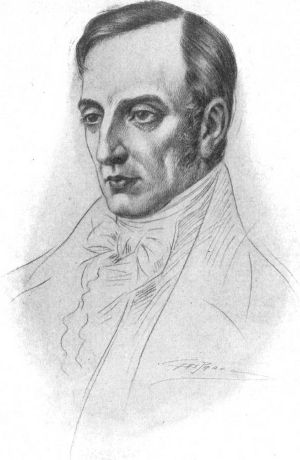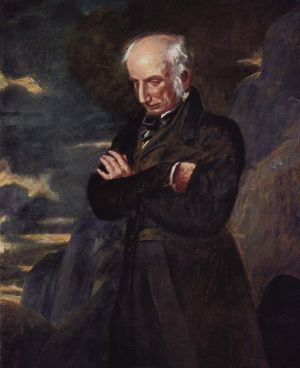Difference between revisions of "William Wordsworth" - New World Encyclopedia
Nathan Cohen (talk | contribs) (Wordsworth article established) |
Nathan Cohen (talk | contribs) m (Credit where credit is due) |
||
| Line 70: | Line 70: | ||
www.wordsworth.com | www.wordsworth.com | ||
[[Category:Art, music, literature, sports and leisure]] | [[Category:Art, music, literature, sports and leisure]] | ||
| + | {{credit|48075406}} | ||
Revision as of 18:30, 12 April 2006
William Wordsworth (April 7, 1770 – April 23, 1850) was a major English romantic poet who, with Samuel Taylor Coleridge, helped launch the Romantic Age in English literature with their 1798 joint publication, Lyrical Ballads. Wordsworth's masterpiece is generally considered to be The Prelude, an autobiographical poem of his early years that was revised and expanded a number of times. It was never published during his lifetime, and was only given the title after his death (up until this time it was generally known as the poem "to Coleridge"). Wordsworth was England's Poet Laureate from 1843 until his death in 1850.
Early Life and Education
The second of five children, Wordsworth was born in Cumberland—part of the scenic region in northwest England called the Lake District. With the death of his mother in 1778, his father sent him to Hawkshead Grammar School. In 1783 his father, who was a lawyer and the solicitor for the Earl of Lonsdale (a man much despised in the area), died. The estate consisted of around £5000, most of it in claims upon the Earl, who thwarted these claims until his death in 1802. The Earl's successor, however, settled the claims with interest. After their father's death, the Wordsworth children were left under the guardianship of their uncles. Although many aspects of his boyhood were positive, he recalled bouts of loneliness and anxiety. It took him many years, and much writing, to recover from the death of his parents and his separation from his siblings.
Wordsworth began attending St John's College, Cambridge in 1787. In 1790, he visited Revolutionary France and supported the Republican movement. The following year, he graduated from Cambridge without distinction.
France
In November,1791, Wordsworth returned to France and took a walking tour of Europe that included the Alps and Italy. He fell in love with a French woman, Annette Vallon, who in 1792 gave birth to their child, Caroline. Because of lack of money and Britain's tensions with France, he returned alone to England that year, but he supported Vallon and his daughter as best he could in later life. The Reign of Terror estranged him from the Republican movement, and war between France and Britain prevented him from seeing Annette and Caroline again for several years. There are also strong suggestions that Wordsworth may have been depressed and emotionally unsettled in the mid 1790s.
First Publication and Lyrical Ballads
1793 saw Wordsworth's first published poetry with the collections An Evening Walk and Descriptive Sketches. He received a legacy of £900 from Raisley Calvert in 1795 so that he could pursue writing poetry. That year, he also met Samuel Taylor Coleridge in Somerset. The two poets quickly developed a close friendship. In 1797, Wordsworth and his sister, Dorothy, moved to Somerset, just a few miles away from Coleridge's home in Nether Stowey. Together, Wordsworth and Coleridge (with insights from Dorothy) produced Lyrical Ballads (1798), an important work in the English Romantic movement. The volume had neither the name of Wordsworth or Coleridge as author. One of Wordsworth's most famous poems, "Tintern Abbey", was published in the work, along with Coleridge's "The Rime of the Ancient Mariner". The second edition, published in 1800, had only Wordsworth listed as author. A third edition of "Lyrical Ballads," published in 1802, contained more poems by Wordsworth, including a preface to the poems. This Preface to "Lyrical Ballads" is considered a central work of Romantic literary theory. In it, Wordsworth discusses what he sees as the elements of a new type of poetry, one based on the "real language of men" and which avoids the poetic diction of much eighteenth-century poetry. Here, Wordsworth also gives his famous definition of poetry as "the spontaneous overflow of powerful feelings from emotions recollected in tranquility."
Germany
Wordsworth, Dorothy, and Coleridge then travelled to Germany. During the harsh winter of 1798-1799, Wordsworth lived with Dorothy in Goslar, and despite extreme stress and loneliness, he began work on an autobiographical piece later titled The Prelude. He also wrote a number of famous poems, including "the Lucy poems." He and his sister moved back to England, now to Grasmere in the Lake District, and this time with fellow poet Robert Southey nearby. Wordsworth, Coleridge, and Southey came to be known as the "Lake Poets". Through this period, many of his poems revolve around themes of death, endurance, separation, and grief.
Marriage
In 1802, he and Dorothy travelled to France to visit Annette and Caroline. Later that year, he married a childhood friend, Mary Hutchinson. Dorothy did not appreciate the marriage at first, but lived with the couple and later grew close to Mary. The following year, Mary gave birth to the first of five children, John.
Both Coleridge's health and his relationship to Wordsworth began showing signs of decay in 1804. That year Wordsworth befriended Robert Southey. With Napoleon's rise as emperor of France, Wordsworth's last wisp of liberalism fell, and from then on he identified himself as a conservative.
Autobiographical Work and Poems in Two Volumes
Wordsworth had for years been making plans to write a long philosophical poem in three parts, which he intended to call The Recluse. He had in 1798-99 started an autobiographical poem, which he never named but called the "poem to Coleridge", which would serve as an appendix to The Recluse. In 1804 he began expanding this autobiographical work, having decided to make it a prologue rather than an appendix to the larger work he planned. By 1805, he had completed it, but refused to publish so personal a work until he should have completed the whole of The Recluse. The death of his brother, John, in 1805 affected him strongly.
In 1807, his Poems in Two Volumes were published, including "Ode: Intimations of Immortality from Recollections of Early Childhood". Up to this point Wordsworth was known publicly only for Lyrical Ballads, and he hoped this collection would cement his reputation. Its reception was only lukewarm, however. For a time, Wordsworth and Coleridge were estranged over the latter's opium addiction.
Two of his children, Thomas and Catherine, died in 1812. The following year, he moved to Rydal Mount, Ambleside where he spent the rest of his life.
The Prospectus
In 1814 he published The Excursion as the second part of the three-part The Recluse. He had not completed the first and third parts, and never would complete them. However, he did write a poetic Prospectus to "The Recluse" in which he lays out the structure and intent of the poem. The Prospectus contains some of Wordworth's most famous lines on the relation between the human mind and nature:
- my voice proclaims
- How exquisitely the individual Mind
- (And the progressive powers perhaps no less
- Of the whole species) to the external World
- Is fitted:—and how exquisitely, too,
- Theme this but little heard of among Men,
- The external World is fitted to the Mind . . .
Some modern critics recognise a decline in his works beginning around the mid-1810s. But this decline was perhaps more a change in his lifestyle and beliefs, since most of the issues that characterise his early poetry (loss, death, endurance, separation, abandonment) were resolved in his writings. But, by 1820 he enjoyed the success accompanying a reversal in the contemporary critical opinion of his earlier works.
Dorothy suffered from a severe illness in 1829 that rendered her an invalid for the remainder of her life. In 1835, Wordsworth gave Annette and Caroline the money they needed for support. The government awarded him a civil list pension amounting to £300 a year in 1842.
The Poet Laureate
With the death in 1843 of Robert Southey, Wordsworth became the Poet Laureate. When his daughter, Dora, died in 1847, his production of poetry came to a standstill.
Death of Wordsworth
William Wordsworth died in Rydal Mount in 1850 and was buried at St Oswald's Church in Grasmere.
His widow Mary published his lengthy autobiographical "poem to Coleridge" as The Prelude several months after his death. Though this failed to arouse great interest in 1850; it has since come to be recognised as his masterpiece.
The lives of Wordsworth and Coleridge, in particular their collaboration on the "Lyrical Ballads," are discussed in the 2000 film Pandaemonium.
External links
- Bartleby.com's complete poetical works by Wordsworth
- Selected Poems by W.Wordsworth
- Collection of Poems and Quotes by William Wordsworth
- A Wordsworth FAQ by Thomas C. Gannon
- Biography and Works
- Works by William Wordsworth. Project Gutenberg
- Poetry Archive: 166 poems of William Wordsworth
- To Toussaint Louverture - poem by William Wordsworth
- The Wordsworth Trust
- Extensive Information on Wordsworth's Poem, Lines Written a Few Miles above Tintern Abbey
www.wordsworth.com
Credits
New World Encyclopedia writers and editors rewrote and completed the Wikipedia article in accordance with New World Encyclopedia standards. This article abides by terms of the Creative Commons CC-by-sa 3.0 License (CC-by-sa), which may be used and disseminated with proper attribution. Credit is due under the terms of this license that can reference both the New World Encyclopedia contributors and the selfless volunteer contributors of the Wikimedia Foundation. To cite this article click here for a list of acceptable citing formats.The history of earlier contributions by wikipedians is accessible to researchers here:
The history of this article since it was imported to New World Encyclopedia:
Note: Some restrictions may apply to use of individual images which are separately licensed.

